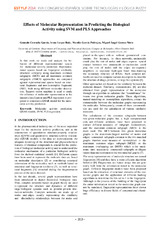Mostrar el registro sencillo del ítem
Effects of Molecular Representation in Predicting the Biological Activity using SVM and PLS Approaches
| dc.contributor.author | Cerruela García, Gonzalo | |
| dc.contributor.author | Luque Ruiz, Irene | |
| dc.contributor.author | García Pedrajas, Nicolás | |
| dc.contributor.author | Gómez-Nieto, Miguel Ángel | |
| dc.date.accessioned | 2018-10-17T12:19:46Z | |
| dc.date.available | 2018-10-17T12:19:46Z | |
| dc.date.issued | 2014 | |
| dc.identifier.uri | http://hdl.handle.net/10396/17331 | |
| dc.description.abstract | In this work we study and analyze the behavior of different representational spaces for molecular activity prediction. Representational spaces based on fingerprint similarity, structural similarity using maximum common subgraphs (MCS) and all maximum common subgraphs (AMCS) approaches are compared against representational spaces based on structural fragments and non-isomorphic fragments (NIF), built using different molecular descriptors. Support vector machine is used to study the influence of molecular representation in the dataset classification and PLS regression is proposed to construct a QSAR model for the molecular activity prediction | es_ES |
| dc.format.mimetype | application/pdf | es_ES |
| dc.language.iso | eng | es_ES |
| dc.rights | https://creativecommons.org/licenses/by-nc-nd/4.0/ | es_ES |
| dc.source | En: ESTYLF 2014, XVII Congreso Español sobre Tecnologías y Lógica Fuzzy, Zaragoza, 5-7, febrero, 2014, 363-368 (2014) | es_ES |
| dc.subject | Molecular activity prediction | es_ES |
| dc.subject | QSAR models | es_ES |
| dc.subject | SVM | es_ES |
| dc.subject | PLS regression | es_ES |
| dc.title | Effects of Molecular Representation in Predicting the Biological Activity using SVM and PLS Approaches | es_ES |
| dc.type | info:eu-repo/semantics/conferenceObject | es_ES |
| dc.rights.accessRights | info:eu-repo/semantics/openAccess | es_ES |

